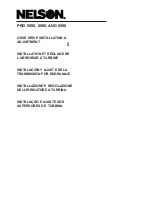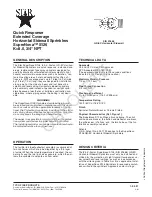
11 Reference Information
This chapter is a learning reference that briefly covers knowledge essential to understanding GNSS Compass
and INS generally. It explains the following concepts in simple terms so that people unfamiliar with the
technology may understand it:
l
, including Global Navigation Satellite System (GNSS) , Inertial Navigation
System (INS) and Attitude and Heading Reference System (AHRS)
l
11.2 The Sensor Co-ordinate Frame
l
11.3 The Body Co-ordinate Frame
l
l
10.4.13 Geodetic Position Packet
l
l
11.1 Technology Overview
11.1.1 GNSS
GNSS stands for Global Navigation Satellite System. A GNSS consists of a set of satellites in medium Earth
orbit that broadcast navigation signals with a common operator. These navigation signals can be picked up by a
GNSS receiver on the earth to estimate that receiver’s position and velocity. For a long time the only operational
GNSS was the United States GPS. However, the Russian GLONASS, the Chinese BeiDou GNSS, and the
European Union’s Galileo GNSS are fully operational.
GNSS provides a fairly accurate absolute position (down to 1.2 metres without assistance and as low as 8 mm
with) and velocity (as low as 0.007 metres/second). The main drawback of GNSS is that the receiver must have
a clear signal from at least 4 satellites to function. GNSS signals are very weak and struggle to penetrate
through buildings, trees and other objects obstructing an uninterrupted view of the sky. GNSS can also
occasionally drop out due to disturbances in the upper atmosphere, or the presence of jammers.
11.1.2 AHRS
AHRS stands for Attitude and Heading Reference System. An AHRS uses accelerometers, gyroscopes and
magnetometer data combined in a mathematical algorithm to provide orientation. Orientation consists of the
three body angles roll, pitch and heading.
11.1.3 INS
INS stands for Inertial Navigation System. An inertial navigation system can provide position and velocity
similar to GNSS but with some major differences. The principle of inertial navigation is the measurement of
acceleration, which is then integrated into velocity. The velocity is then further integrated to estimate position.
Due to noise in the measurement and the compounding of that noise through the integration steps, inertial
navigation has an error that increases exponentially over time. Inertial navigation systems have a very low
relative error over short time periods but over long time periods the error can increase enormously.
11.1.4 GNSS/INS
By combining GNSS and INS together in a mathematical algorithm, it is possible to take advantage of the
benefits of the long-term precision of GNSS and the short-term accuracy of inertial sensors. This provides an
v2.0
Page 121
04 Nov 2021
GNSS Compass Reference Manual • GNSS Compass Reference Information
Summary of Contents for GNSS Compass
Page 1: ...GNSS Compass Reference Manual v2 0 04 Nov 2021 ...
Page 28: ......







































